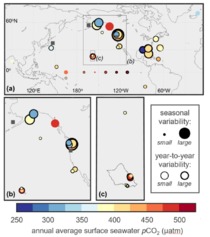New trend detection paper and a time-series data product
PMEL's CO2 buoy team and partners published a paper using time-series observations from a global network of forty buoys to characterize rates of ocean carbon change. The ocean exhibits remarkable variability in both space and time of surface ocean carbon, particularly in coastal regions (Figure). This variability can complicate, and at times obscure, detection and attribution of longer-scale ocean changes resulting from the absorption of increasing atmospheric carbon dioxide (CO2). This work suggests it will require as much as four decades of observations to detect an anthropogenic signal at coastal buoy time-series stations. At the two open ocean sites where only one decade of observations makes it possible to detect an anthropogenic signal above natural variability, seawater partial pressure of CO2 (pCO2) is changing at the same rate as atmospheric CO2 over the same time period. Open ocean sites such as these may serve as early indicators if the ocean sink cannot keep pace with CO2 emissions.
Associated with this paper is a data product providing easier access to these standardized, climate-quality surface ocean carbon time series, a key need of the modeling community for ocean model validation and interpretation. Given these observations are collected every three hours, this time-series data product will allow for unprecedented analysis of ocean processes that impact surface ocean pCO2 at scales from days to years. These types of data sets contribute to reducing uncertainties in climate and ocean acidification projections through quantification of natural variability and long-term trends.
The time-series data product is also more accessible to students, researchers from other disciplines, and marine resource managers who may not have a seawater CO2–carbonate chemistry
background or the resources necessary to process and interpret the more detailed deployment-level data archived at NCEI.
Climate-quality, time-series observations represent critical components of the climate observing system and are one of the best tools for tracking rates of change of ocean acidification globally.


